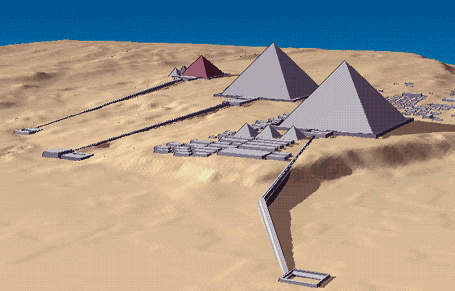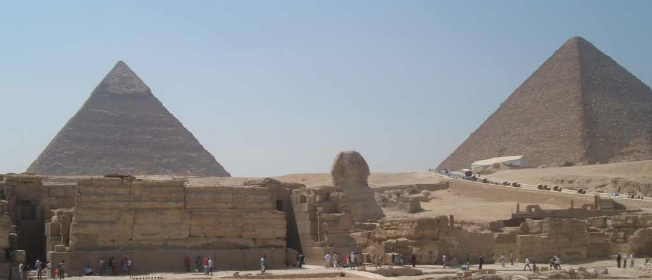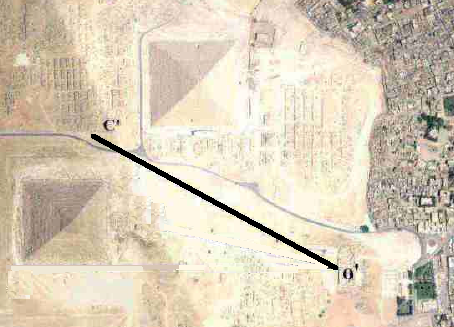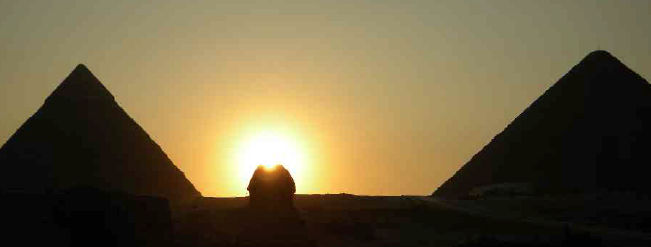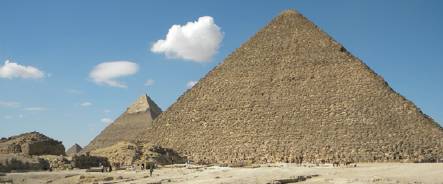Pyramids at Giza - 11,000 or 36,000 years old?
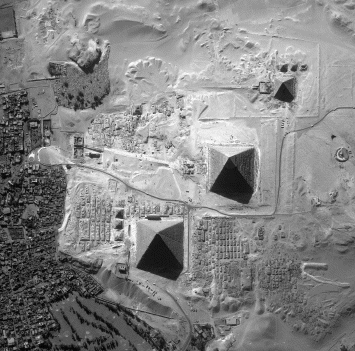
The image above is from the Ikonos satellite.
The image below, of the probable original plan of the Pyramids, is from the Giza Plateau Computer Model of The Oriental Institute of The University of Chicago:
My working hypotheses are:
the 3 Giza pyramids were built as a group at the time
the Sphinx was built;
that the Sphinx was built about 11,300
to
13,000 years ago, around the time
Vela X exploded and Vega was North Star
or
about 36,000 years ago, around the time Geminga shock wave
hit Earth, and Vega was also then North Star
or
about 36,000 years ago, around the time Geminga shock wave hit Earth, and Vega was also then North Star
When did Humans first arrive at Giza? What did they do ?
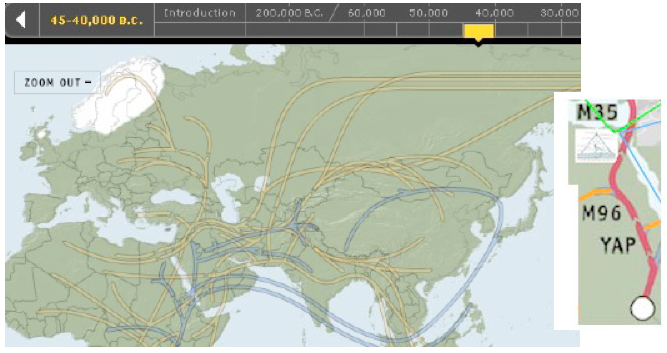
Around 40,000 years ago my YAP and M96 ancestors had migrated into the Nile River Valley.
36,000 BP - M96 continued up Nile to build the Great Pyramid
and during its construction to invent the efficient Hebrew Alphabet.
It was the time of Late Wisconsin Glaciation
and the time that the shock wave of the Geminga Supernova hit the Earth
and beginning of Manetho’s Rule of Gods on Earth (36,000 to 22,000 BP)
The Builders of the Great Pyramid had migrated throughout the length of the Nile
along which substantially contiguous settlements enabled them to maintain enough
contact to maintain the details of the oral traditions of IFA so that when they built the
earliest of the pyramids, the Great Pyramid and the Second Pyramid, they did not deface them with any writing
but instead encoded the IFA Clifford Algebra in the structure of the Pyramids themselves.
22,000 BP - M35 leaves M96 and Africa to cross Mediterranean
from the Nile Delta into the Middle East and Kosovo / Macedonia
Manetho’s Rule by Demigods and Spirits of the Dead (22,000 to 11,000 BP)
ended after Ice Age when sea levels rose requiring agri-tech for survival
Manetho’s Rule of Mortal Humans began 11,000 BP
which was about 25-26,000 years after the Geminga shock wave.
11,000 BP also had a supernova (Vela X).
HERE are Some Opinions about
Egyptian Chronology.
Evidence for all the Giza structures being built at once (more or less, due to time needed for construction) is only circumstantial: they all seem to "fit together" as part of an overall plan. I would like to see independent direct proof, as would Eric Liebrich, who raised this point with me by e-mail. One possible way to get such proof might be to look at the only remaining limestone facing of the 3 Giza pyramids, on the top of the second pyramid, and see what kind of weathering it shows. Maybe for some reason such as its shape (such as being steep, or being made of small blocks instead of one big rock like the Sphinx) weathering studies of the limestone facing at the top of the second pyramid might be inconclusive, but I would like to see the results of an attempt to do such weathering studies.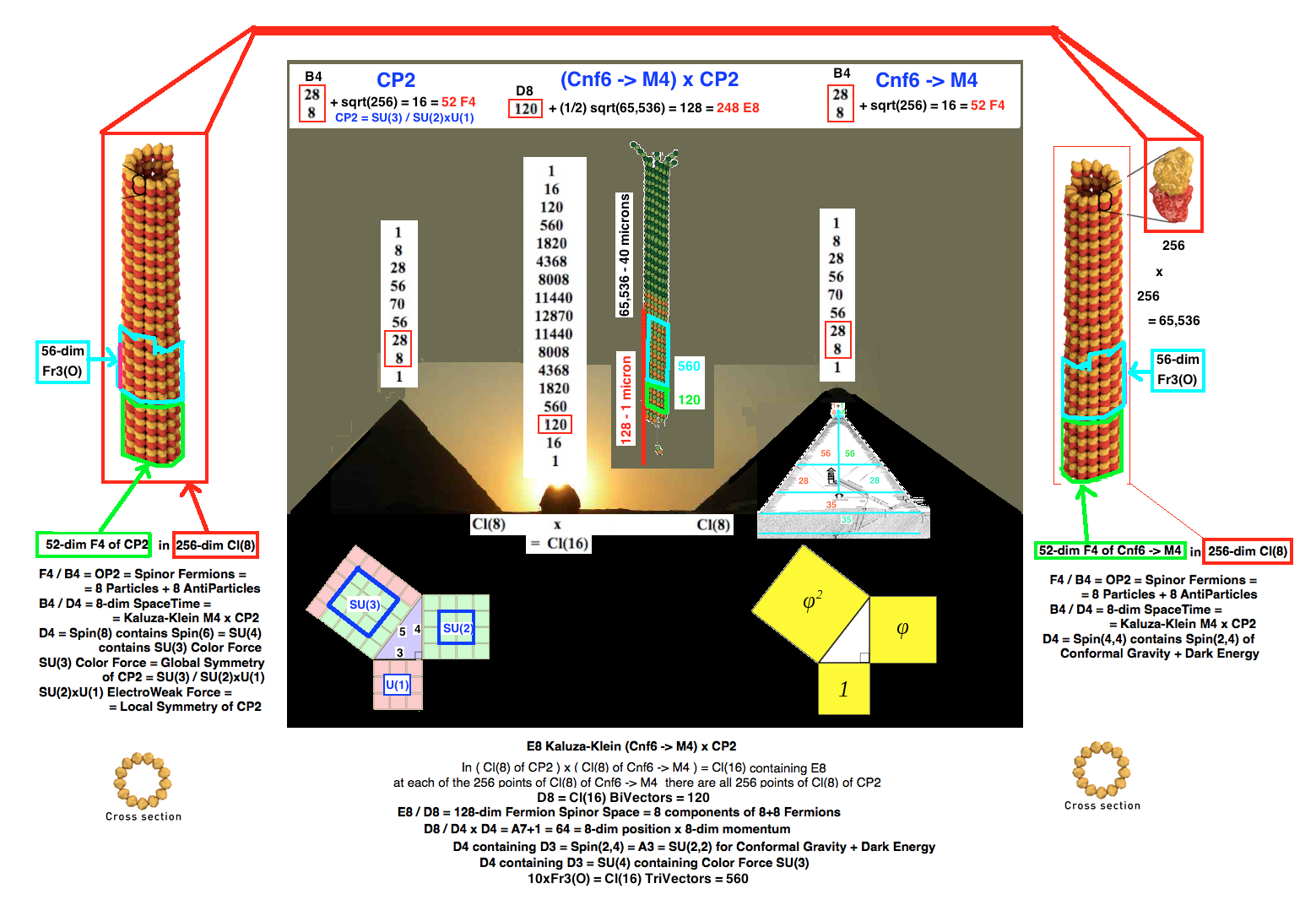
The 3 Giza pyramids were the only large ones successfully built near the Golden Mean PHI angle of about 52-degrees, but as John Legon and others have noted, all 3 may not have exactly the same slope. The Great Pyramid has a slope of a little less than 52 degrees that can be represented by the Golden Ratio as arccosine( 1 / ((1 + sqrt(5))/2) ) = 51.8 degrees. As the capstone of the Great Pyramid is missing, and its faces are not flat, the slope given is an average for the part below the capstone. The Second Pyramid has a slope of a little over 53 degrees that can be represented by the 3-4-5 Pythagorean triangle as arccosine( 3 / 5 ) = 53.1 degrees. The Third Pyramid has a slope of very roughly 51 degrees that can be represented by the square root of 2 times 10/9, or about sqrt(2) times (1 + 1/10 + 1/100 + 1/1000 + ...), as arccosine( 9 / (10 sqrt(2) ) = 50.5 degrees. Therefore the 3 Pyramids might each represent: the Golden Ratio; the 3-4-5 Pythagorean triangle with 9+16=25; and the square root of 2 times 10/9. In my opinion, all 3 Giza pyramid angles are close enough to roughly 52 degrees to be considered by their builders to approximately square the circle whose radius is their height. I think that the 3 Giza pyramids were built as a group at the time the Sphinx was built.
Giulio Magli in arXiv 0708.3632 and 1401.0508 and Journal of Cosmology, 2010, Vol 9, 2232-2244
said:
"... the two main pyramids of Giza together with their
temples ... were conceived as parts of a common project ...
From left to right the Valley Temple and the remains
of the Sphinx Temple in front of the Sphinx. ...
The Sphinx ... is a huge statue with the body of a lion and human (or divine) head.
The head was carved in a small rocky hill, while the body was obtained excavating
a huge precinct from which the blocks for the temple were quarried ...
The Sphinx was probably intended to associate the king with the sun god
and, as a consequence, the temple in front of it was a sun temple. ...
very precisely oriented to due East ...
In the background the Giza 2 and Giza 1 pyramids ...
... Googlearth image of the Giza 1 / Giza 2 complexes ...
The line O’C’ is directed towards the midpoint of the segment
which separates the south-west corner of Giza 1 and the north-east corner of Giza 2.
The azimuth of this line is ~28° north of west,
and therefore coincides with that of the sun at the summer solstice ...
the summer solstice took place roughly in concomitance with the beginning of the Nile flood ...
... Thus, the midsummer sun is seen setting in between the two pyramids ...
... when the midsummer sun sets, an observer ... from an area in front of the Sphinx ...
actually witnesses the formation of a spectacular replica of the hieroglyph Akhet
......
This is by all means a hierophany, a manifestation of divinity which happens every year
in dependence of a celestial cycle. Indeed, the hieroglyph Akhet, meaning “horizon”,
had a profound symbolic meaning for the ancient Egyptians.
It was composed by the hieroglyph djew standing for “primeval mountain”
(a mountain with two peaks, “supporting” the heaven) and the sun setting ... in between.
The symbol was therefore associated with the afterlife as well,
since the solar cycle was associated with life and rebirth. ...
in the Nile valley everybody knew that the meaning of the two giant pyramids was
that the king soul was scheduled to live in eternity joined with the sun.
...
... the “Giza diagonal” ... is an ideal line which connects the south-east corners
of the three pyramids with good accuracy ... points in the direction of the city of Heliopolis ...
an extremely important religious center; it was called Iunu, pillar,
and was a sort of “umbilicus mundi” of the country.
The city was sacred to the sun and housed a temple of this god ...
the high priest of Heliopolis was called “Chief of the Observers” ...
looking from Heliopolis (and ... from any other point lying nearby the “Giza diagonal” line)
the Giza pyramids seem to “contract” on each other ... their images merge into that of the Great Pyramid.
... the effect of the diagonal is that ... the second pyramid becomes invisible from the city. ...
... only approaching the city of the Sun god - which was a “symbolic pillar” by itself -
that the double-peaked horizon of the great king ... reduces to a single ... giant ... pyramid. ......".
According to whc.unesco.org "......".
long before other pyramids were built much later, around 4500-4000 years ago. At the later times, people tried to copy the 52-degrees slope, but had lost the technology, so: they failed (Meidum collapse); tried again and bent the top part of the Bent Pyramid to 43-degrees in order to avoid another collapse; then gave up and went to 43-degrees with the Red Pyramid; and then just gave up on pyramids, the later ones being worse and worse. During the later times, people modified and added to the original Giza complex structures. The Age of Leo is defined as the period in which the precession of the equinoxes (a 26,000 year cycle stabilized by the moon and sun) brings the constellation Leo, and its alpha star Regulus, into the background of the rising sun at the Spring equinox. Now, almost half a cycle later, the Age of Pisces is coming to an end. The Age of Leo coincided with the Vela X supernova that formed the Gum Nebula, and with the floods that came with the Holocene end of the Ice Age. When Vela X went supernova about 11,000 years ago, it was the brightest star in the sky. Aside from Vela X, Sirius (the alpha star of Canis Major) was the brightest star in the sky.
With respect to Constellations of Stars, the Egyptians identified:
- Osiris=Orion, whose alpha star is Betelgeuse,
- Isis=Sirius, whose Egyptian Gnostic followers produced a table related to the tarot that may have encoded principles of the Book of Thoth, and
- Thoth=Vela X, identified with learning writing and agriculture from their goddess Seshat, the principal wife of Thoth.
With respect to our Solar System, the myths of the Egyptian Gods may describe the history of our Solar System:
- Ra=Sun,
- Tefenet=Comets
- Hathor=SuperNovae,
- Geb=Earth,
- Nut=Moon,
- Heh Twins=Venus+Mercury,
- Isis=Jupiter,
- Nephthys=Saturn,
- Seth/Horus=Mars, and
- Osiris=Asteroids
With respect to the History of
Humans on Earth, the character of the Egyptian god Osiris
parallelled that of Quetzalcoatl of the Maya and Viracocha of
the Inca, in that Osiris left Egypt in charge of Isis to visit
the rest of the earth and teach men agriculture and
civilization.
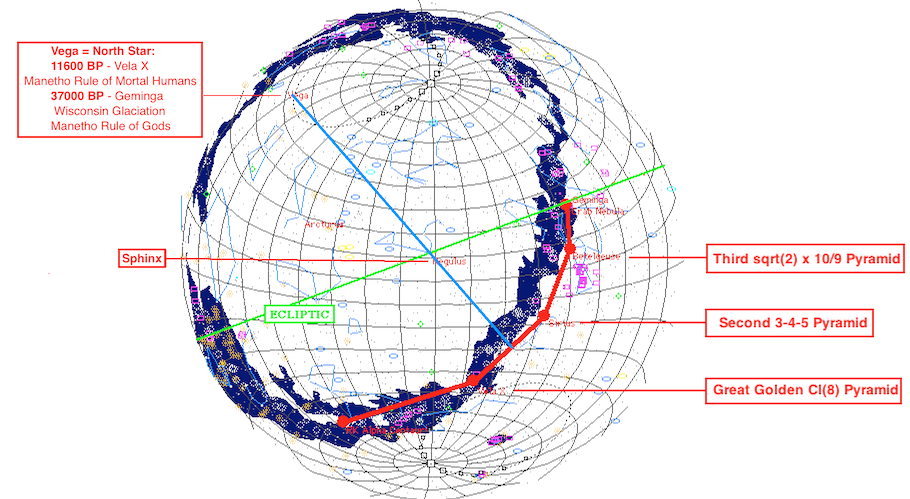
Now, compare the star pattern with the reflected plan of Giza: Let the River Nile correspond to the Milky Way, and let the pyramids correspond to the stars: the Third Pyramid to Betelgeuse (Osiris); the Second Pyramid to Sirius (Isis); and the Great Golden Pyramid to Vela X (Seshat and Thoth). The arc through Betelgeuse, Sirius, and Vela X intersects the ecliptic at the Crab Nebula/Geminga. Just as the Causeway from the Second Pyramid leads to the Sphinx which faces a rising Leo, Sirius faces Regulus, so the Sphinx corresponds to Regulus. It is interesting to compare the reflection that is needed for the correspondence between the plan of Giza and stars in the sky with the reflection that is needed for the correspondence between a Lo Pan and stars in the sky.
The Giza Pyramids and Sphinx not only correspond to stars, but also to largest feature on Earth, the Pacific Ocean. Part of the basin of the present Pacific Ocean may be a remnant of an impact crater (the Lunar impact crater) of a Mars-sized body with Earth about 4,400 million years ago resulting in the formation of the Moon. The water to fill the basin and form the Earth's first oceans could have been introduced by cometary impact or by outgassing from Earth's rocks prior to about 3,800 million years ago. Perhaps early continents on Earth were formed as an antipodal dome by the impact of the Moon's formation, and perhaps some of the old parts of present-day Africa could be remnants of such a dome. These are only conjectures on my part, as there is not much detailed evidence of continental positions in the very distant past. For example, it is known that Africa has remained roughly stationary for the past 200 million years or so, but whether or how it has moved during the preceding 4,200 million years is not well known. Also, it is known that the Pacific Ocean has existed for at least the past 750 million years, but whether it was formed then or was in existence for some or all of the preceding 3,450 million years is not well known. It is interesting to me that some southern African hot spots are antipodal to the central Pacific hot spot of Hawaii, now near Mauna Loa. My conjectural picture is that:
- the core of the Pacific Basin is the remnant of the Lunar impact crater;
- continents were raised as an antipodal dome due to the Lunar impact; and
- since the Lunar impact, tectonic activity on Earth has
broken up and rearranged the original continents, and oceans
such as the Atlantic have formed and re-formed.
(For references as to cometary water and as to the Pacific Ocean, see Solar System Evolution, by Stuart Ross Taylor (Cambridge 1992), Piecing together the Pacific, by Garry Davidson (New Scientist (18 January 1992) 25-29). Also, thanks to Sean D. Birkel for criticism of an earlier version of this page. He does not agree with my conjectures, but his criticisms are very helpful to me in trying to improve my understanding of such things.)
If the Giza Pyramids and Sphinx represent the Pacific Ocean, then the central Second Pyramid should correspond to Mauna Loa. An interesting aspect of this correspondence is that the Hawaiian Islands and Giza have similar latitudes with respect to the magnetic North Pole and, if on a great circle between the Hawaiian Islands and Giza, the geographic North Pole is near the midpoint. What about the other two Pyramids and the Sphinx?
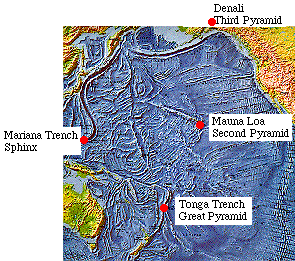
The Great Pyramid represents the Tonga Trench, 35,433 feet deep, the second lowest point in the Pacific Ocean. The Second Pyramid represents Hawaiian Mauna Loa, 13,680 feet, the highest island in the Pacific Ocean. The Third Pyramid represents Denali, 20,320 feet, the highest point in North America, where the western convergent subduction Pacific boundary meets the eastern transform strike-slip Pacific boundary. The Sphinx represents the Mariana Trench, 35,840 feet deep, the lowest point in the Pacific Ocean. To the best of my knowledge, the first person to recognize Giza-Pacific correspondences was Gary Jones (jonescc@sanet.com), whose correspondences are similar, particularly of Hawaii with the Second Pyramid, to the ones I use, but not completely identical. The Pacific map is taken from the Hammond Atlas of the World (1993).
Now consider the alignment of the 3 pyramids. They are lined up: large; medium; small; so you might ask whether they are lined up in artistic perspective to go to a vanishing point, an idea due to Stephen Goodfellow. The 3 pyramids are not lined up in a straight line, so there is no LINEAR vanishing point. However, on a 2-dimensional sphere like the surface of the Earth (or the celestial sphere of the sky) elliptic conformal geometry of the sphere allows you to treat circles and lines as the same thing. To look at the perspective of the 3 pyramids using elliptic spherical conformal geometry, look at the hemisphere of each pyramid, and project each hemisphere down onto a common ground base elevation, the surface of the Earth sphere. Since the 3 pyramids were built according to the Golden Ratio, they each "squared the circle". That is, the total circumference of the base is the circumference of a circle whose radius is the height of the pyramid. So, the hemisphere of each pyramid is the sphere whose center is the center of the base of the pyramid and whose radius is the height of the pyramid. The top of the sphere is then the apex of the pyramid. Then, instead of running straight perspective lines through outside corners of the bases of each pyramid, you should run perspective circle curves through: 1. the center of the circular base of each hemisphere, which is also the pyramid apex projected to the ground; 2. the outer perspective circle should be tangent to the outside of the circular base of each hemisphere; and 3. the inner perspective circle should be tangent to the inside of the circular base of each hemisphere. Then all three perspective circles will meet at TWO vanishing points.
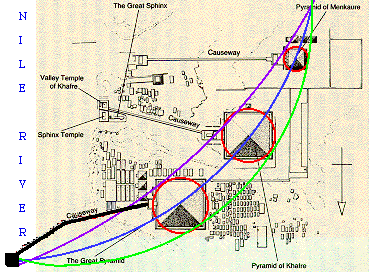
In the case of straight line perspective in a plane, there is only one FINITE vanishing point, but there is a second one at infinity. Our elliptic spherical geometry has two vanishing points in all cases, because the sphere is made from a plane by including the point at infinity as the North Pole. One of the two vanishing points, the NorthEast one, is near the end of the causeway leading from the Great Pyramid. It corresponds to the nearest star system, the triple star system containing Rigel Kent, or Alpha Centauri. The other vanishing point is near the southern outer boundary wall of the Giza complex beyond the Third Pyramid. John Legon has noted that, while other outer boundary walls of the entire Giza complex are straight and oriented North-South or East-West, this wall runs West to East about 7 degrees South of East, and is not straight, but appears to be the arc of a circle of radius of curvature about 11,000 cubits, which is approximately the total perimeter of the entire Giza complex, a square about 2,750 cubits per side, with the vanishing points being at the NorthEast and SouthWest corners. The SouthWest vanishing point beyond the Third Pyramid is not particularly near any large known structure at Giza. With respect to the stars, it corresponds to the anticenter of the Milky Way, the antipodal point on the celestial sphere of the center of the Milky Way in Sagittarius. The Plane of the Ecliptic intersects the Milky Way near its center and its anticenter. One thing near the anticenter is the Crab Nebula pulsar.

Here is a Chandra X-ray picture of the Crab Nebula:

The Crab Nebula and its pulsar
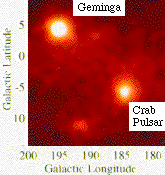
were created by a supernova that exploded about 7,500 years ago. Since it is about 6,500 light years away, it was not seen on Earth until about 1,000 years ago, on 4 July 1054 AD. Bauval and Hancock (The Message of the Sphinx, Crown 1996) noticed that the Crab Nebula is near the crossing of the Milky Way by the Plane of the Ecliptic. Another pulsar in the area is Geminga, about 500 light years away. Geminga has high tranverse velocity, about 120 km/sec or about 0.4 light years per 1,000 years, moving toward Orion from Gemini, currently at about 1 degree per 20,000 years. Geminga's radial velocity is unknown, but if it were 200 km/sec, or 0.67 light year per 1,000 years, it could have been within 300 light years of Earth at 340,000 years ago. Geminga is bright in X-rays and gamma rays, but optically very dim (25th mag) and hard to detect, hence its name (Milanese for "It's not there."). It has a period of 4 pulses per second so that it is probably no older than about 340,000 years. As its spinning could have slowed down faster if it had starquake glitches, it could have exploded as a supernova somewhat earlier. Ellis, Fields, and Schramm have studied the possible geological consequences of the Geminga supernova. They cite evidence for anomalous 10Be abundance about 35,000 years ago. If Geminga exploded about 340,000 years ago, and then were only about 300 light years from Earth, and if Geminga's shock wave and accumulated material travelled at 400 km/sec, or about 1 light year per 1,000 years, they could have arrived at Earth about 35,000 years ago, when Cro-Magnons appeared. Geminga's radiation, on the other hand, would have hit Earth about 340,000 years ago, very roughly when Neanderthals appeared.
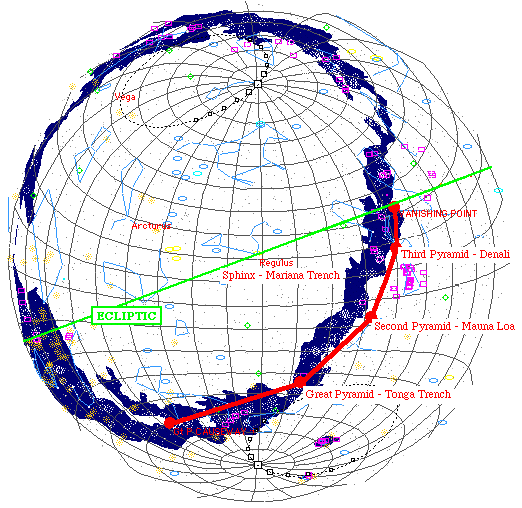
The correspondences are reinforced by: the existence of three small pyramids near the Third Pyramid, like the 3 Pearl stars of the Belt of Orion near Betelgeuse; the existence of one small pyramid near the Second Pyramid, since Sirius is a binary star, with bright Sirius A having a faint dwarf-star companion (Sirius B), something known to ancient Egyptians and African tribes such as the Dogon; and the existence of many small structures near the Great Golden Pyramid, like the many stars of the Milky Way in the neighborhood of Vela X.
The star maps were made with Voyager II for Macintosh.
More interesting stuff about history, math, and other things can be found on an Egyptian Hieroglyphics page, a page on the geometry of the Great Golden Pyramid, a page on the layers, or courses, of the Great Golden Pyramid, and a page on the Temple of Luxor.
For general Egyptological references, and links to many more, go to ANTHONY'S EGYPTOLOGY & ARCHAEOLOGY HOME PAGE.
Some Opinions about Egyptian Chrononlogy:
PBS NOVA has an Online Exploration of the Giza Pyramids and Sphinx
with commentary by Mark Lehner and Zahi Hawass,
who advocate an age of about 4,600 years for the Giza pyramids.
Mark Lehner says "... we know ... the date of the pyramids
... mostly by context.
The pyramids are surrounded by cemeteries of other tombs.
... we find organic materials ... that can be radiocarbon dated
... But primarily we date the pyramids by their position
in the development of Egyptian architecture and material
culture over the broad sweep of 3,000 years. ..."
I agree with the dates of the materials found
in the area of the Giza pyramids, but
I do NOT agree that those materials, tombs, etc., are
the materials, tombs, etc., of the builders
of the Giza Pyramids and Sphinx.
In my opinion, the builders were either
the Ice Age Civilization of 36,525 to 11,600 years ago,
or, at the latest,
a part of a global Early Human Civilization
that broke up about 6,000 years ago,
and
that the Giza Sphinx and Pyramids were
already built about 5,100 years ago when Menes reunited
Lower Egypt, including Giza, with Southern Upper Egypt.
Mark Lehner also says "... Since most of the outer casing
[of the Great Pyramid] is missing what you see now
is the step-like structure of the core.
... they didn't join the [core] stones very accurately.
... I noticed that in the interstices between the stones
and in this mortar was embedded organic material,
like charcoal, probably from the fire that they used
to heat the gypsum in order to make the mortar.
...we saw in many places ... fragments of tools,
bits of pottery ... characteristic of the Old Kingdom.
... we did a first [radiocarbon dating] run in 1984
... of some 70 samples from a whole selection of pyramids of
the Old Kingdom ... getting dates
... that were on the average 374 years too old for the
Cambridge Ancient History ... dates [such as 2550 BC for Khufu]."
Mark Lehner in 1986 said (Hancock and Bauval, Message of the Sphinx,
Crown 1996, p. 307) that 15 mortar samples from the Great Pyramid
were dated by radioactivity at
"... dates [that] run from 3809 BC to 2869 BC
... significantly earlier than the best Egyptological date
for Khufu ... almost like a Bell curve ... when you cut it
down the middle ... 400 to 450 years too early ..."
In my opinion, when Menes reunited Upper Egypt and Lower Egypt,
with a capital in the Abydos-Luxor-Thebes region,
around 5,100 years ago, the Southern Upper Egyptians
(whose culture was more advanced technologically
in areas from copper working to constructing walled cities)
came into control of the Giza area and its preexisting
Pyramids and Sphinx. When the high-tech Southern Upper
Egyptians got control of the Giza monuments, they began
to do restoration and repair work. In so doing, they
did two things:
1 - almost all the "evidence" of the Lower Egyptian occupation
of the Giza plateau was obliterated; and
2 - repair mortar, tools, pottery, etc., of the
unifying Southern Upper Egyptians were introduced into
the Giza monuments, beginning about 5,100 years ago,
or about 3100 BC, or about 550 years before the era
of Khufu in 2550.
My scenario is consistent with a few dates due to surviving
Lower Egyptian activity between 6,000 years ago and 5,100 years ago,
but
the preponderance of the dates being since 5,100 years ago,
and prior to 2550 BC, due to the introduction of Southern
Upper Egyptian high-tech restoration activity.
The scenario of construction of the Great Pyramid by Khufu
around 2550 BC, about 4,550 years ago, is NOT consistent
with the radioactivity dating results.
As Mark Lehner says: "... just recently we took some 300 samples,
and ... are now in the process of dating these samples
... maybe we can pick up the subject of the results
... (during ... February [1997]...)."
Like Mark Lehner,
I look forward to results of tests of the 300 new samples,
but I do not see how they could invalidate the earlier
test results of the 1980s.
If the new results are NOT consistent with the 1980s results,
then, since the 1980s tests were probably done properly,
I would conclude that something is wrong with the radioctivity
dating methods, and all such results should be rejected.
Mark Lehner also says "... the great boat that was found just south
of the Great Pyramid ... was radiocarbon dated -
- coming out about 2,600 B.C. ..."
I do not disagree with the date of the Great Boat at about 2600 BC,
as I think that such a boat could indeed have been constructed
by Khufu around that time.
I think that:
the "boat pits" of the Great Pyramid
were constructed when the Great Pyramid was built;
the first of the large (143 feet) wooden boats were built
by the seafaring global Early Human Civilization that
built the Giza Pyramids and Sphinx;
the boats, being wooden, wore out while they were being
used for ocean travel, with worn-out boats being replaced
with new copies throughout the centuries;
that Khufu replaced worn-out boats with new copies,
but, since Khufu's civilization was no longer seafaring,
he just left the new copies in the boat pit, unused until now.
As to another matter, Zahi Hawass says "... All the five relieving
chambers are inscribed. ... there are some inscriptions
there that cannot be written by anyone except
the workmen who put them there. You cannot go and reach there.
It has to be the man who put the block above the other one
to do that. ..."
The inscriptions are shown in a photograph on page 51 of Mark Lehner's book The Complete Pyramids (Thames and Hudson 1997):
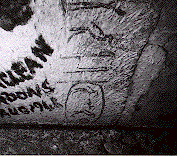
In my opinion, the "graffitti which included the name of the Pharaoh Khufu" is (like the other graffitti) of more recent origin than the construction of the Great Pyramid, perhaps being daubed on by workers during the 1837 expedition of Howard Vyse that blasted open a passage to that Ceiling Chamber. I disagree with the July 1998 position statement of Graham Hancock saying that "... I have changed my views on the validity of the forgery theory. The relieving chambers are strictly off limits to the public and are extremely difficult to gain access to. ... However, in December 1997, Dr Zahi Hawass allowed me to spend an entire day exploring these chambers. There were no restrictions on where I looked and I had ample time to examine the hieroglyphs closely, under powerful lights. Cracks in some of the joints reveal hieroglyphs set far back into the masonry. No 'forger' could possibly have reached in there after the blocks had been set in place - blocks, I should add, that weigh tens of tons each and that are immovably interlinked with one another. The only reasonable conclusion is the one which orthodox Egyptologists have already long held - namely that the hieroglyphs are genuine Old Kingdom graffiti and that they were daubed on the blocks before construction began. ..."
Adrian Gilbert and Robert Bauval, in The Orion Mystery, propose that a North-South reflection of the plan of the Pyramids of Giza matches the pattern of the 3 Pearls, or stars of the Belt of Orion. I got the idea of looking for star patterns by reading their work, but I do not agree with the assignment of the Pyramids of Giza to the 3 stars of the Belt of Orion, and I also disagree with the July 1998 Graham Hancock position statement saying that "... the three great pyramids in general are likely to be much younger than the Sphinx and that they should probably be assigned to the Fourth Dynasty (rather than to any other period) because of the alignments of the star shafts. ..." In July 1998 Rober Bauval wrote a position statement in which he notes "... the alignment of the southern shaft of the King's Chamber in the Cheops pyramid with Orion's belt (precessed to the epoch c.2500 BC). ...".
Graham Hancock, in Fingerprints of the Gods, following R. A. Schwaller de Lubicz and John West, noticed that the water-weathering of the Sphinx was consistent with the Sphinx being built, not just 4,000-5,000 years ago, since when the weather in Giza has been very arid, but during the Age of Leo, 11,000-13,000 years ago. Robert Schoch's geological examinations of the Sphinx are consistent with the 11,300-13,000 year age range during which I propose that the Giza Pyramids and the Sphinx were constructed.
According to a January 2002 article by Colin Reader on a web page of the Manchester Ancient Egypt Society: "... The idea that the pyramids of Egypt may have been built from a kind of concrete, were first proposed in a 1988 book - "The Pyramids - an Enigma Solved". The author, Joseph Davidovits, was a French chemist and an expert in artificial stone. He argued that to build the pyramids, the Egyptians had taken quarried stone, pulverised it and then wet it up with a number of additives such as gypsum to provide a cement. To build a pyramid, all that was needed was a workforce with lots of buckets and ladders to carry the wet cement to the work face, where it was poured into moulds to create the estimated 2.5 million blocks used in the Great Pyramid. ... The majority of blocks used to build the pyramids (the core blocks) are not so carefully worked ... with irregular gaps between 2cm and 30cm typically found in the core masonry of the Great Pyramid. The irregular finish of these blocks, with chisel marks, handling bosses etc., is enough to demonstrate quite clearly that these blocks have not been cast in a mould. ... what about the casing stones, in which the finish is so well worked and regular that a piece of paper can barely be inserted in the joints? I happened ... to visit the British Museum, where a fragment of the Tura limestone casing of the Great Pyramid is on display. Under no circumstances could that material be considered an artificial 'stone'! The fragment in the BM has clearly been sawn and worked - sharp 'lips' on some of the edges of the piece would not form if a mould had been used to cast this stone. ...
... The limestones in Egypt do frequently appear to be disturbed. This however is as a result of the conditions in which the rocks were laid down, with the sediments from which the limestones were formed, deposited in high-energy shallow seas - within the tidal zone. The limestone beds show clear evidence of these conditions, with reefs, shoals, sand banks etc. preserved in the rock. The fossils within the limestones are disturbed, but this is the result of the origin of these rocks, not what man has done to them since they were laid down. ...
... A quick glimpse of the granite casing of Menkaure's pyramid at Giza, shows that like the Tura casing of the Great Pyramid, this casing too has not been cast. The blocks of granite were clearly delivered from the quarry only roughly shaped, to ease handling and to allow the completed casing to be dressed to a uniform finish when in place. ...".
According to AP on 2 March 1998, researchers say that a complex of stone slabs and structures in southern Egypt was built perhaps as far back as 7,000 years ago. J. McKim Malville of the University of Colorado at Boulder, an astrophysics professor, describes the stone complex in the journal Nature with anthropologist Fred Wendorf of Southern Methodist University in Dallas and other researchers. The monument was discovered over several years of field work ending in 1997. The Egyptian complex, which isn't circular like Stonehenge, is spread over an area of 1.8 miles by about three-quarters of a mile. It includes 10 large slabs about nine feet high, 30 rock-lined ovals, nine burial sites for cows (each under a pile of 40 to 50 rocks weighing up to 200 or 300 pounds each) and a ``calendar circle'' of stones. Many of these features line up in five radiating lines, including one running due east-west, the researchers said. The calendar circle is a 12-foot-wide arrangement of slabs about 18 inches long, most of them lying down. Two pairs of upright stones stand directly across the circle from each other, defining a view that would have displayed sunrise at the summer solstice, researchers said. The circle also contains two other pairs of standing stones that defined a north-south view. Charcoal from hearths around the circle and wood from one of the burial sites date to about 7,000 years old. It's not clear when most of the rest of the monument was erected, but it was at least 5,000 years ago, Wendorf said.
......
